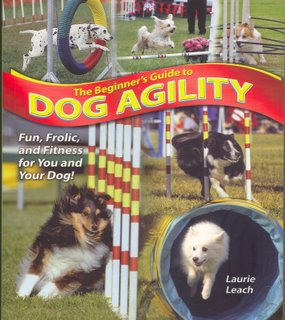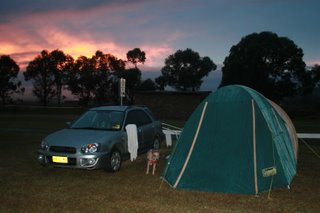
June 28, 2006
Body Language
Eyes - Your dog is aware of where you are looking, look at the obstacle you want him to perform next.
Shoulders - They are a powerful communication tool. A turn of the shoulders indicates a change of direction, and the degree of rotation tells how sharp the turn will be. A drop of one shoulder is a cue that the handler is going to rear cross, or cross behind the dog.
Arms - There are three basic ways to use your arms, all arm signals are given with the arm closest to the dog. Bowling the dog is where, palm up, you swing the arm towards the next obstacle. Drawing a path is where you point with one finger moving your arm to show the dog the correct path to the next obstacle, so your arm is close to your body if your dog is to stay close to you, and your arm is outstretched if your dog is to stay further away. Pushing is using an open palm and a push motion to widen the dog's path away from you.
Feet - Dogs, particularly small dogs, learn to read your feet like the arrow on a compass. Your feet should face the next obstacle as soon as possible.
Position - Your position in relation to the dog also tells it where it is to go on course. Lead outs and front and rear crosses give precise information about where the dog is to go next.
June 26, 2006
Starters Agility

At an ADAA training camp on the weekend Dusty ran her first full length course. She wasn't really up to this step, but handled it well apart from a tendency to run over to me after every few obstacles. She had lovely contacts, dropping and waiting for the release, and quick responses to the front crosses and post turn. We haven't started training the weaves so I called her past them to the tunnel.
June 23, 2006
Bongo - RSPCA
IMG_1183
Originally uploaded by marj k.
Partly out of guilt at buying myself such an expensive toy, I'm using the new camera to photograph dogs and cats at the local RSPCA shelter, so that they can publicise re-homable animals on their website. So many wonderful pets - they don't have issues or problems, just got too big or too active, or became inconvenient.
I adore Dusty, and needed a 'well bred' dog after the heartbreak of losing Diesel - and Duz shows her good breeding in so many ways - but my next dog will be a rescue.
I almost shook a woman at the dog beach today who was telling me that her reason for breeding her labrador (to a neighbour's lab, no health checks anywhere) was that if she throws back to her chocolate lab mother, the puppies will be 'worth quite a bit'.
Stock Handling
Wombramurra Station near Nundle in NSW looked good, with flexible packages including a 'work for your board' option, however despite its great web site, the contact numbers don't work and it looks like it might have changed hands.
Cruickshank's is a bed and breakfast on a sheep property near where I go for herding lessons, it might be possible to negotiate some work experience.
Leconfield offers a Jillaroo/Jackaroo school, which teaches a whole range of skills I have limited use for such as shoeing a horse and building bush furniture, but they cover stock handling.
Jim Lindsay of LSS runs schools that teach Low Stress Stockhandling, delevoping an attitude that promotes harmony between man and animal. "We can put ourselves in a position to be able to consider the situation from an animal's point of view and therefore have an obligation to do so. When we have knowledge of how an animal reacts to different situations we can use that information to effect. Being an effective stockhandler is about knowledge, understanding, attitude and patience.
Working Dog Schools cover the basic fundamentals of working a herding dog. Herding dogs are those that instinctively have a desire to go around their stock and keep the stock together and bring them back to the handler. The schools are designed to give the handler an insight into how working dogs think and want to operate. The most important thing in a working dog is to have a desire to work. When that is established the handler must understand how to control that desire. Heavy emphasis is placed on letting the dog work as naturally as it wants in order to get the job done. Sometimes this takes a considerable amount of understanding on behalf of the handler. Understanding this process and putting it into practice can be very rewarding."
June 20, 2006
Zen and the art of herding

Robert starts the session by asking where you are at, and what you want to achieve. I said I was looking for some sort of herding zen - a state of acceptance and peace that involved sheep and wilful red cattle dogs.
Dusty standing, loose leashed, watching the sheep a couple of feet away was a big start.
Soft Start
Not too much was asked of us the clinic last weekend. I worked on trying to read Dusty and the sheep, anticipating what they were going to do, and her response to them, trying to get myself in the best place to let her do what she knew she had to do.
I know trust is a big part of it - trusting that she has good instincts and has been taught well and then just giving her freedom to do her job. I was about to give up herding, I was worried about my inability to be in control at all times but I think I now understand that I don't have to be.
If you get a chance to go to a Robert Cox clinic, do yourself a favour. He is as good at reading people as he is at reading dogs and sheep.
June 14, 2006
Weekend Results
Dusty coped with very trying conditions and ratty sheep to get two passes in her Herding Tests to earn her HT. After her second test I took them out to a open space and she literally had the zoomies, racing around in big circles through bushes and across the not-quite dry dam. Apparently she was exhibiting more self control in the ring than I had given her credit for.
Best of all they both snuggled up to me in the tent, alleviating the deficiencies of my mild-weather-only sleeping bag.


